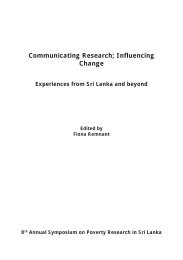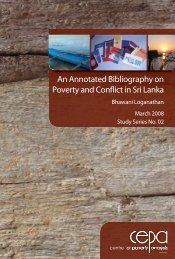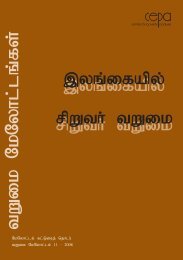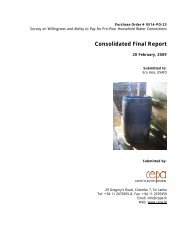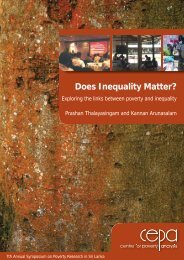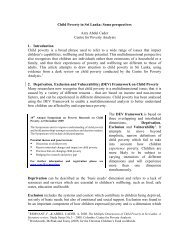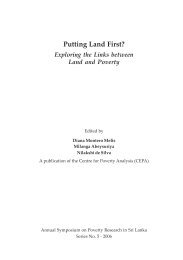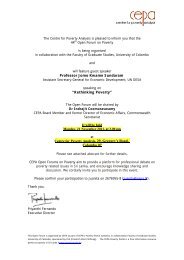Involuntary Displacement and Resettlement â Policy and ... - CEPA
Involuntary Displacement and Resettlement â Policy and ... - CEPA
Involuntary Displacement and Resettlement â Policy and ... - CEPA
- No tags were found...
You also want an ePaper? Increase the reach of your titles
YUMPU automatically turns print PDFs into web optimized ePapers that Google loves.
the country in the late 1980s <strong>and</strong> 1990s contributed to shape the agency’spolicy in engaging with IDPs in other conflicts around the world.According to Jens et al. (2002:4), UNHCR was present in Sri Lanka since1987 to assist with the repatriation <strong>and</strong> reintegration of Tamil refugeesreturning from India. The repatriation programme continued intermittently(when conditions allowed) until 1995. At the same time, UNCHR becamemore involved with Sri Lanka’s growing population of IDPs, many of whomwere to be found in the same areas to which the refugees were returning.Jens et al. show how, in 1990, the Government of Sri Lanka formally askedUNHCR to provide assistance to IDPs on both sides of the conflict. Anarrangement that was formalized in 1993 through a Memor<strong>and</strong>um ofUnderst<strong>and</strong>ing between UNHCR <strong>and</strong> the Sri Lankan government: Theextension of UNHCR’s m<strong>and</strong>ate to cover assistance to IDPs in Sri Lanka wasagreed by the UN Secretary-General in 1991 <strong>and</strong> reaffirmed in a March 1997letter from the UN Secretary-General’s office, stating that UNHCR “maycontinue to co-ordinate the UN efforts for humanitarian assistance forinternally displaced persons in Sri Lanka.” However, as William Clarance(2007) shows, UNHCR took on these responsibilities quite reluctantly.Clarance describes the discrepancies between the field officers in Sri Lanka<strong>and</strong> UNHCR’s head office in Geneva in taking on responsibility for the IDPs inSri Lanka. This took place amidst much internal controversy but has laterproved to represent a major shift in the broadening of their responsibility asan agency for forced migrants – not only refugees.Francis Deng’s first country mission, following his confirmation in 1993 asrepresentative of the secretary-general, was to Sri Lanka (Weiss <strong>and</strong> Korn2006). The UN/Brookings group subsequently came in <strong>and</strong> worked actively<strong>and</strong> successfully to make the IDP category <strong>and</strong> the accompanying GuidingPrinciples 7 known in Sri Lanka (see, for example, Jayatillake 2003). UNHCRalso continued to disseminate knowledge about the category <strong>and</strong> theGuiding Principles to all levels of the government administration. Thesevarious initiatives paved the way for the established underst<strong>and</strong>ing of IDPsin Sri Lanka .7The Guiding Principles on Internal <strong>Displacement</strong> set out in one document the internationalhuman rights obligations that are binding through international treaties <strong>and</strong> how these obligationsare applicable in situations of internal displacement. According to Susan Carr (2009), theyremain soft law <strong>and</strong>, as such are non-binding.8A notable change has taken place with the government having won the so-called ’Final War’.New terms have come into common usage: old <strong>and</strong> new IDPs, with new IDPs being thosepeople who were displaced after 2006. The IDPs discussed in this paper are ‘old IDPs’.134



